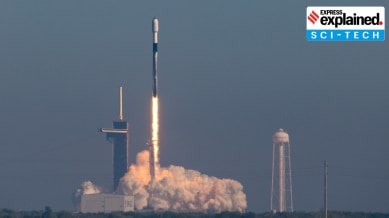What caused the rare failure of SpaceX’s Falcon 9 rocket
The mishap occurred on the rocket’s 354th mission, and marks the first Falcon 9 failure since 2015

The US Federal Aviation Administration (FAA) on Friday grounded SpaceX’s Falcon 9 — one of the world’s most active rockets — after the failure of its upper stage engine that stranded 20 Starlink internet satellites in a low, non-survivable orbit. The failed mission ended a remarkable streak of more than 300 successful Falcon 9 flights in the last nine years.
What is Falcon 9?
Falcon 9 is a partially reusable rocket designed and manufactured by Elon Musk-owned SpaceX. It can transport crew and payloads to low Earth orbit (an altitude of 2000 km or less) and beyond.
The rocket has two stages. The first stage or booster stage comprises nine Merlin engines (a family of rocket engines developed by SpaceX), and aluminium-lithium alloy tanks containing liquid oxygen and rocket-grade kerosene propellant. The second stage consists of a single Merlin engine.
The first stage, which is reusable, is capable of re-entering the atmosphere, and landing vertically after separating from the second stage.
What went wrong with Falcon 9?
The issue occurred roughly 30 minutes after the launch of Falcon 9 from the Vandenberg Space Force Base in California on Thursday night. The rocket’s second stage experienced a liquid oxygen leak, and failed to complete a second, short engine burn needed to put 20 Starlink satellites in the correct orbit, according to a post on SpaceX’s website.
“After a planned relight of the upper stage engine to raise perigee — or the lowest point of orbit — the Merlin Vacuum engine experienced an anomaly and was unable to complete its second burn,” SpaceX said.
“Although the stage survived and still deployed the satellites, it did not successfully circularise its orbit. This left the satellites in an eccentric orbit with a very low perigee of 135 kilometres (84 miles), which is less than half the expected perigee altitude.”
SpaceX claimed that the stranded satellites do not pose any threat to other satellites, or public safety as they are expected to entirely burn up in the Earth’s atmosphere.
The mishap occurred on the rocket’s 354th mission, and marks the first Falcon 9 failure since 2015, when the rocket exploded on a launch site in Florida. Falcon 9 is considered one of the most successful and reliable rockets ever made.
What happens next?
The rare failure is expected to impede Falcon 9’s launch pace. In 2023 alone, the rocket made 96 launches, and exceeded the annual launch total in any country, according to a report by Reuters. “By comparison, China, a space rival to the United States, launched 67 missions to space in 2023 using various rockets.”
The grounding of Falcon 9 is also likely to postpone upcoming missions taking astronauts to orbit. The private Polaris Dawn mission spearheaded by the entrepreneur Jared Isaacman is slated for the end of July. The rocket is also scheduled to take four astronauts to the International Space Station (ISS) for NASA in mid-August — Falcon 9 is the only US rocket capable of taking NASA astronauts to ISS.
The rocket will remain grounded till the time SpaceX investigates the cause of failure, fixes the issue, and gets approval from the FAA.